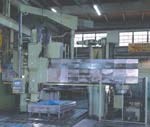Control Keeps Press Manufacturer Competitive
The Web Press Division of KBA North America Inc. (York, Pennsylvania), a builder of high speed presses for newspaper printing, recently investigated its need for improved control in the production of parts used in its equipment construction.
Share





The Web Press Division of KBA North America Inc. (York, Pennsylvania), a builder of high speed presses for newspaper printing, recently investigated its need for improved control in the production of parts used in its equipment construction. KBA Plant Manager Daryl Sanderson says, "We had a 100-foot Waldrich Siegen gantry mill with a 60-position toolchanger onboard, which was being moved to our plant from Germany, where our parent company is located. We wanted to retrofit the mill with a control. So, we needed a contractor who was local, experienced and mobile enough to do the work at our facility. As you can imagine, transporting such equipment is a very daunting task."
After a review of the available contractors, the bid was awarded to Quality Machining Services, Inc. (QMS) in nearby Shartlesville, Pennsylvania. QMS specializes in the remanufacture and on-site retrofit of machine tools, ranging from centerless grinders, lathes and spline mills to machining centers and such mammoth equipment as the gantry mill at KBA.
Both KBA and QMS selected the Siemens 840 from Siemens Energy & Automation (Elk Grove Village, Illinois) as the CNC for its user-friendly communication protocol, easy integration into the overall manufacturing data network, 32-bit processor, full-color 3D display and enhanced memory. QMS President Charles Rhoads explains, "We do our own software programming, so time is money for our customer and us. We set up the panel and then started our troubleshooting. Every single point was powered up, then traced back through the controller, including every relay-to-solenoid, motor direction, tool position, table position and more. The 840 with WOP has an easy-to-use operator interface, so the operator programs the part, not the control, on every job. And, the real-time graphic programming is performed at the machine tool while machining is taking place."
This gantry mill is used primarily to produce printing press frame sides. Hole drilling, facemilling, spotmilling, groove/contour milling and other operations are performed with the 60-position ATC. A sliding, multi-position bed allows one workpiece to be machined while others are loaded/unloaded. Up to 64 tool and material parameters for each operation are supported by the control, as well as various approach and retraction strategies. Thus, the operator can apply his or her particular skill set to each job at hand, based on experience with a particular job, material or cutting sequence. Since this equipment has such substantial operating costs, the more sophisticated control allows faster setup, real-time programming and greater overall production.
As the part is machined, the 840 control allows a KBA operator to inspect the work from several views by rotating the workpiece around various axes on-screen with a zoom function. Complete machining functions can be cut and pasted for another similar part in real-time for the next job, which is especially useful in this application where a run of one is typical.
Mr. Rhoads comments further on the upsides of this control for the Waldrich Siegen gantry mill. "When there are so many individual parts machined with similar but slightly different specs, programming time can far exceed machining time. So, the control needs higher power and faster programming options to keep production going and, therefore, keep the company competitive."
Related Content
How this Job Shop Grew Capacity Without Expanding Footprint
This shop relies on digital solutions to grow their manufacturing business. With this approach, W.A. Pfeiffer has achieved seamless end-to-end connectivity, shorter lead times and increased throughput.
Read MoreAutomated CAM Programming – Is Your Software Really Delivering?
A look at the latest automation tools in Autodesk Fusion 360 software and how forward-thinking machine shops and manufacturing departments are using them to slash delivery times and win more business.
Read MoreHow to Mitigate Chatter to Boost Machining Rates
There are usually better solutions to chatter than just reducing the feed rate. Through vibration analysis, the chatter problem can be solved, enabling much higher metal removal rates, better quality and longer tool life.
Read MoreThe Power of Practical Demonstrations and Projects
Practical work has served Bridgerland Technical College both in preparing its current students for manufacturing jobs and in appealing to new generations of potential machinists.
Read MoreRead Next
Setting Up the Building Blocks for a Digital Factory
Woodward Inc. spent over a year developing an API to connect machines to its digital factory. Caron Engineering’s MiConnect has cut most of this process while also granting the shop greater access to machine information.
Read More5 Rules of Thumb for Buying CNC Machine Tools
Use these tips to carefully plan your machine tool purchases and to avoid regretting your decision later.
Read MoreBuilding Out a Foundation for Student Machinists
Autodesk and Haas have teamed up to produce an introductory course for students that covers the basics of CAD, CAM and CNC while providing them with a portfolio part.
Read More


















.jpg;maxWidth=300;quality=90)
















